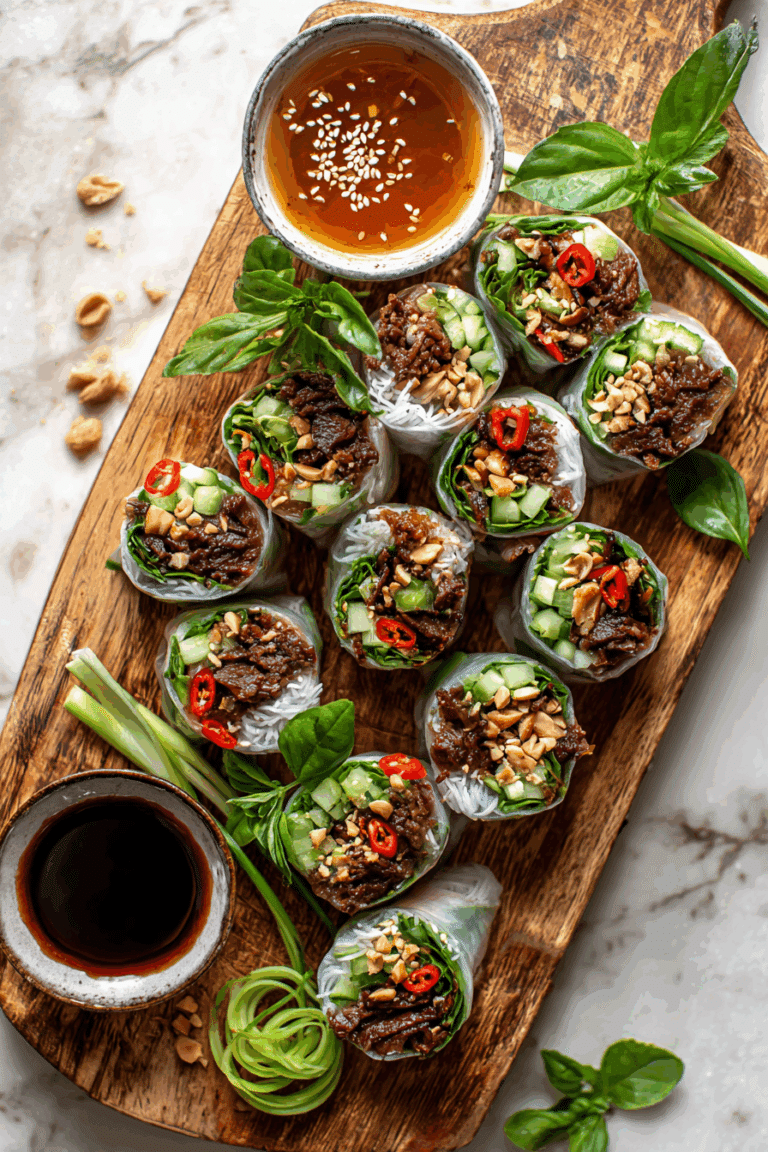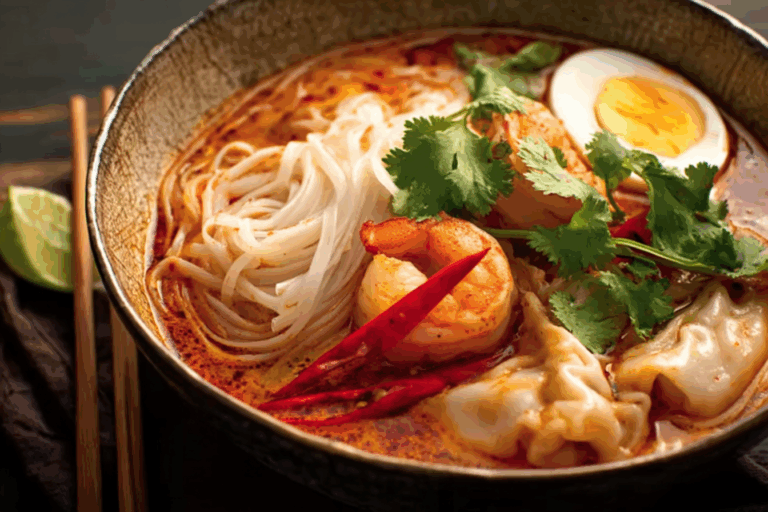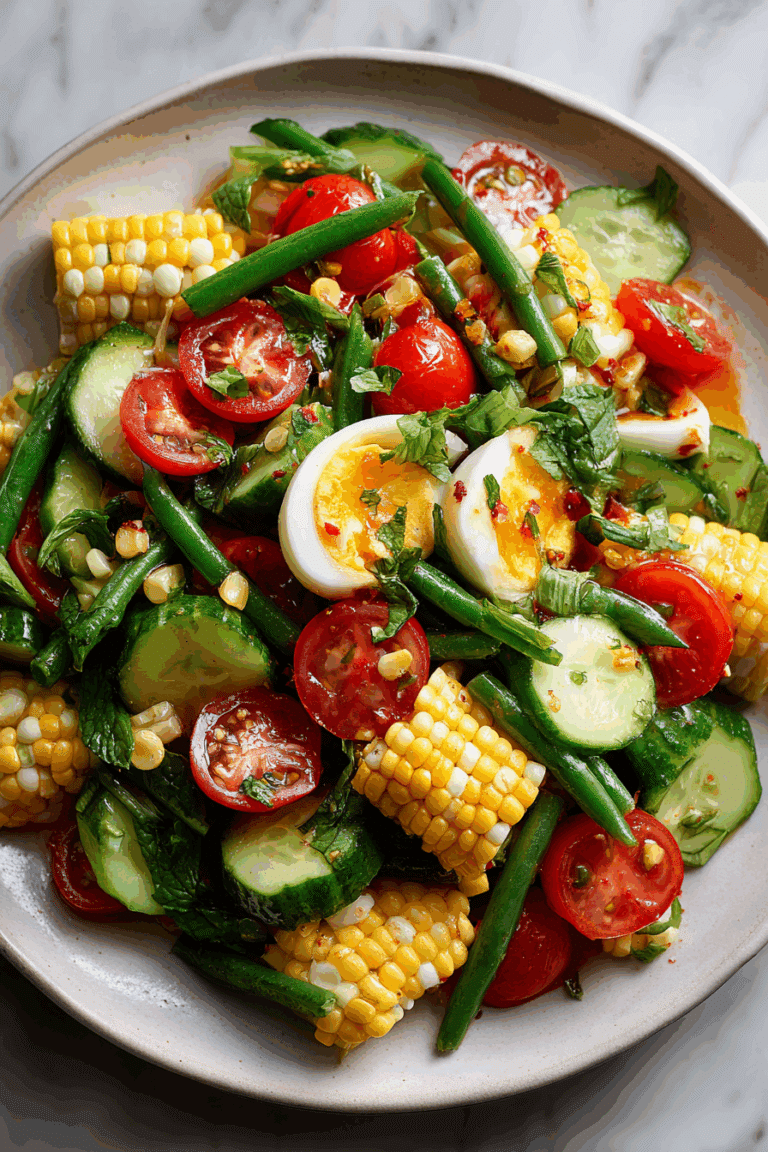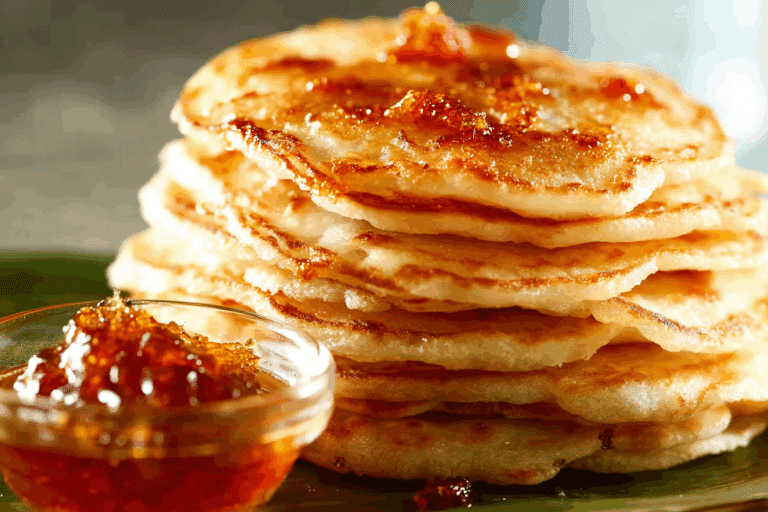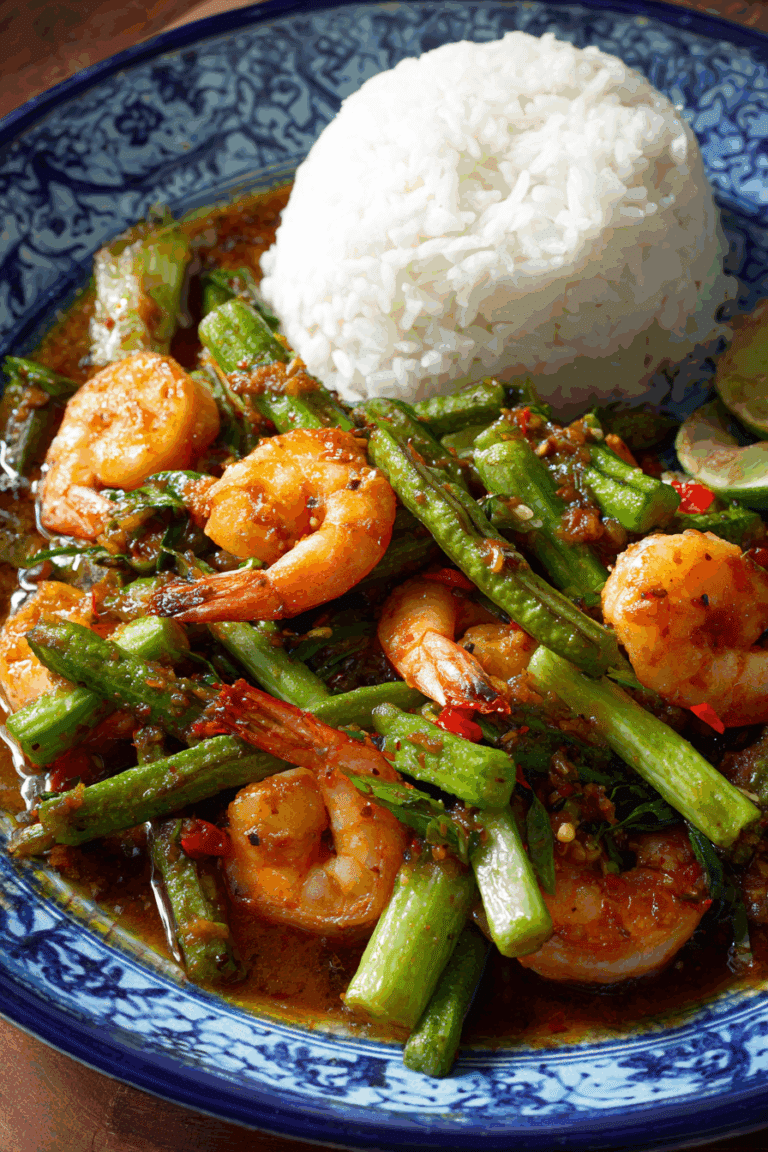Thai Cha-Om Omelette Recipe: A Classic Thai Dish You’ll Love
Thai Cha-Om Omelette Recipe is one of those dishes that reminds me why food is so much more than just what’s on the plate. Whenever I cook this omelette, the fragrance of cha-om leaves sizzling in hot oil instantly brings me back to my first trip to Thailand. Sitting at a roadside stall with a plate of steaming jasmine rice, chili dipping sauce, and a golden omelette filled with cha-om leaves, I felt a kind of joy only food can bring the joy of discovering something so humble yet so delicious.
On the About Page, I shared how my passion for authentic Thai cooking grew from family traditions and travels through Thailand. The inspiration behind starting this site was to bring lesser-known Thai recipes to a global audience, not just the usual curries or stir-fries, but the everyday meals Thai families treasure. The Thai Cha-Om Omelette Recipe is exactly that kind of dish: simple, quick to prepare, yet deeply tied to Thai culture.
In this article, you’ll learn everything you need to know to master this dish: the ingredients, detailed cooking steps, insider tips, creative variations, nutritional benefits, and even the history behind the cha-om vegetable. Whether you’re looking for an authentic Thai Cha-Om Omelette Recipe, an easy Thai Cha-Om Omelette Recipe, or simply curious about cha-om leaves benefits, this guide has you covered.
Table of Contents
Table of Contents
Ingredients
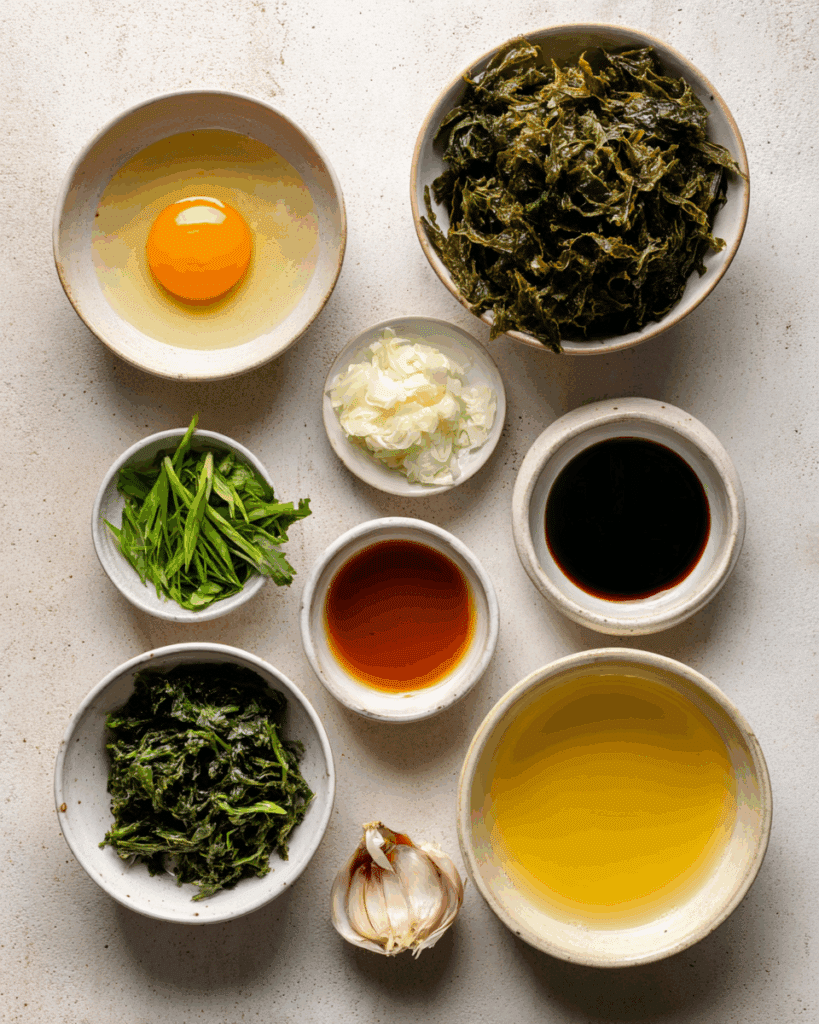
To make the best Thai Cha-Om Omelette Recipe, you’ll need just a handful of simple, traditional Thai ingredients that come together beautifully. Here’s the exact list:
- 2 tablespoons of cooking oil (vegetable oil or sunflower oil works best)
- 1 clove garlic, minced
- 3 large eggs
- 2 1/2 cups loosely packed cha-om (acacia) leaves, roughly chopped
- 1 teaspoon fresh lime juice
- 1/2 tablespoon oyster sauce
- 1 tablespoon fish sauce
Ingredient Insights
The star of the Thai Cha-Om Omelette Recipe is, of course, the cha-om leaves. These leaves come from the acacia plant, known for their unique aroma and earthy flavor. While their smell might seem strong when raw, once cooked with eggs and seasonings, they mellow into something truly delicious.
Eggs form the base, providing protein and richness. Garlic adds fragrance and depth, while fish sauce and oyster sauce give the salty umami punch that defines Thai cooking. The squeeze of lime juice brings balance, cutting through richness with freshness.
For those exploring more Thai flavors, I recommend checking out our recipe for Thai Basil Fried Rice and Thai Green Curry both dishes pair wonderfully with this omelette.
Substitutions
- Cha-om substitute: If you can’t find cha-om, use spinach, tender kale, or even dill for a different but enjoyable taste.
- Vegetarian option: Swap fish sauce for soy sauce or tamari.
- Healthier twist: Use olive oil or avocado oil instead of vegetable oil.
Step-by-Step Instructions
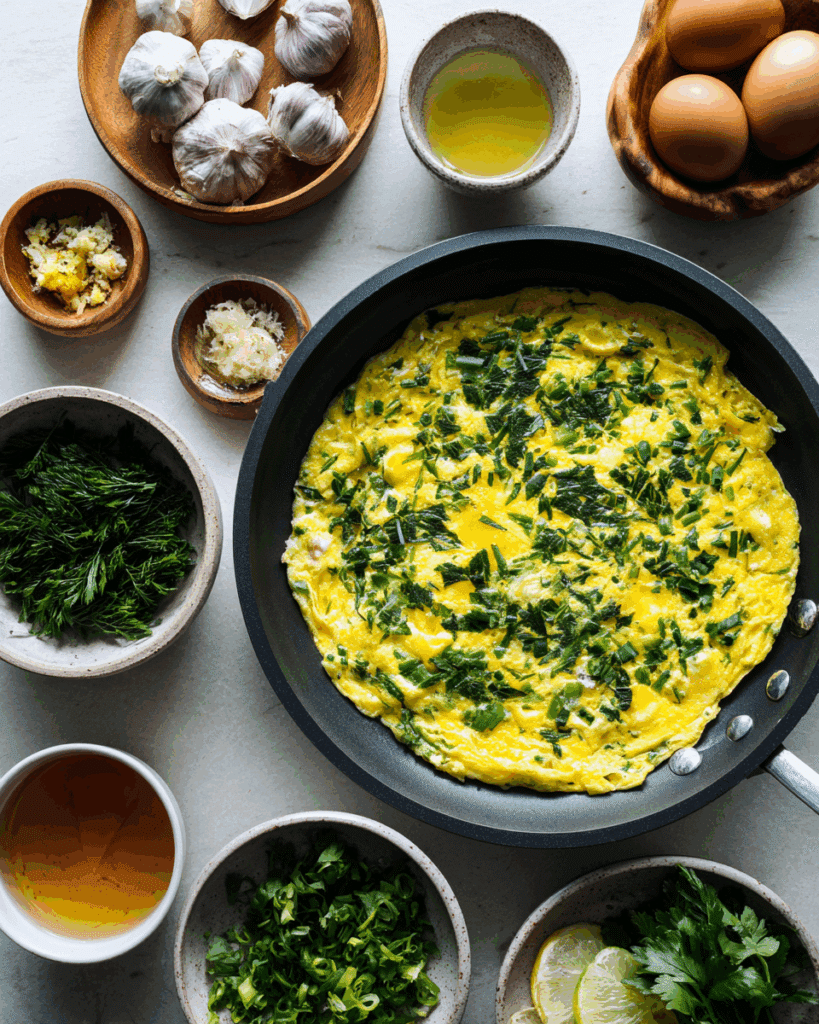
Cooking the Thai Cha-Om Omelette Recipe is straightforward, but mastering the timing makes all the difference. Let’s go step by step.
- Prepare the Ingredients
Begin by mincing your garlic finely. Chop the cha-om leaves into 4–5 pieces to make them easier to mix and distribute in the omelette. - Mix the Egg Base
Crack three large eggs into a mixing bowl. Add the chopped cha-om leaves, fish sauce, oyster sauce, and lime juice. Whisk thoroughly until everything is well combined. - Cook the Garlic
Heat 2 tablespoons of oil in a non-stick skillet or wok over medium-low heat. Add the minced garlic and sauté for about 20 seconds until fragrant and golden. - Pour the Egg Mixture
Carefully pour the egg and cha-om mixture into the hot pan. Spread the leaves evenly across the surface. Let the mixture cook undisturbed until the bottom sets and turns golden. - Flip the Omelette
Gently flip the omelette using a spatula or by sliding it onto a plate and flipping it back into the pan. Cook until the other side is done, golden, and firm. - Serve and Enjoy
Transfer the omelette to a plate and serve immediately. Traditionally, it’s eaten with jasmine rice and a spicy dipping sauce like nam prik kapi.
For a detailed guide with visuals, I recommend visiting Rachel Cooks Thai and Hungry in Thailand. These resources showcase different ways locals prepare and serve the Thai Cha-Om Omelette Recipe, giving you a broader view of its cultural significance.
Tips & Tricks
Making the perfect Thai Cha-Om Omelette Recipe is easier when you know a few insider tips:
- Use medium-low heat: Too high, and you’ll burn the garlic and toughen the eggs. Too low, and the omelette won’t brown properly.
- Beat the eggs well: This ensures fluffiness. For extra lightness, separate the whites, beat them until frothy, then fold into the yolks.
- Don’t overcrowd the pan: A medium pan is ideal for three eggs. Overcrowding prevents even cooking.
- Flip with confidence: If flipping feels tricky, cut the omelette in half and flip each piece separately.
- Spice it up: Add sliced Thai chilies or chili flakes to the egg mixture for a spicy kick.
Variations
One of the joys of the Thai Cha-Om Omelette Recipe is how versatile it is. You can adapt it to your taste or the ingredients you have on hand. Here are some fun variations:
- Authentic Thai Cha-Om Omelette Recipe
Stick to the original formula: cha-om leaves, fish sauce, and oyster sauce. This version tastes just like the ones served in Thai households. - Easy Thai Cha-Om Omelette Recipe
For beginners, reduce the amount of cha-om leaves for a lighter, milder taste. This makes the omelette easier to flip and more approachable. - Stuffed Cha-Om Omelette
Add ground pork, shrimp, or mushrooms to the egg mixture for a heartier dish. - Rice-Topped Omelette
Serve the omelette over jasmine rice, drizzled with soy sauce or chili sauce, for a complete meal. - Crispy Edges Version
Use a bit more oil and higher heat to create crispy golden edges while keeping the inside soft.
Nutrition & Health Benefits
When we talk about the Thai Cha-Om Omelette Recipe, it’s easy to think only about its delicious taste and comforting aroma. But this humble dish is also surprisingly rich in nutrition. Let’s break down what makes the Thai Cha-Om Omelette Recipe both satisfying and healthy.
Macronutrients of the Thai Cha-Om Omelette Recipe
A typical serving of the Thai Cha-Om Omelette Recipe (made with 3 eggs, cha-om leaves, and seasonings) provides:
- Calories: About 210–250 depending on oil used
- Protein: Around 12–14 grams, thanks to the eggs
- Fat: 15–18 grams, mainly healthy fats if cooked with olive oil or sunflower oil
- Carbohydrates: Only 2–3 grams, making this a low-carb option
Eggs in the Thai Cha-Om Omelette Recipe are an excellent source of protein and essential amino acids, which help build and repair muscle. They also provide vitamins like B12, riboflavin, and selenium.
Micronutrients in Cha-Om Leaves
Cha-om leaves are the true nutritional powerhouse of the Thai Cha-Om Omelette Recipe. Although these leaves are not as well-known outside Thailand, their benefits are outstanding:
- Vitamin C: Boosts the immune system and supports skin health.
- Vitamin A: Essential for vision, skin repair, and immune defense.
- Iron: Helps prevent anemia and supports oxygen transport in the body.
- Calcium: Strengthens bones and teeth.
- Antioxidants: Combat free radicals and reduce inflammation.
Cha-om leaves are often celebrated for their fiber content, which aids digestion and helps regulate blood sugar levels. In traditional Thai medicine, cha-om is sometimes used to relieve fatigue and support circulation.
Health Benefits of the Thai Cha-Om Omelette Recipe

The Thai Cha-Om Omelette Recipe is not only a flavorful dish but also one that contributes positively to your overall well-being:
- Weight Management: Low in carbs and high in protein, making it filling without excessive calories.
- Heart Health: Garlic and cha-om leaves contain compounds that support cardiovascular health.
- Digestive Health: Fiber in cha-om leaves promotes a healthy gut.
- Immune Boosting: Vitamin C and antioxidants from cha-om leaves enhance immunity.
- Bone Strength: Eggs and cha-om leaves together provide calcium and vitamin D.
Eating the Thai Cha-Om Omelette Recipe regularly can be part of a balanced diet that prioritizes whole, nutrient-rich foods.
Make-Ahead, Storage & Freezing
A great thing about the Thai Cha-Om Omelette Recipe is its practicality. Whether you’re meal-prepping, saving leftovers, or planning ahead for a busy weeknight, the Thai Cha-Om Omelette Recipe adapts easily to your needs.
Make-Ahead
You can prepare the egg mixture for the Thai Cha-Om Omelette Recipe ahead of time by cracking eggs into a bowl, whisking in fish sauce, oyster sauce, lime juice, and chopped cha-om leaves, then storing it in the fridge. This mixture can sit for up to 24 hours before cooking. Just give it a quick whisk before pouring it into the pan.
This make-ahead method is especially useful if you want to enjoy the Thai Cha-Om Omelette Recipe fresh for breakfast or lunch but don’t have much time in the morning.
Storing Leftovers
Cooked Thai Cha-Om Omelette Recipe leftovers can be stored in an airtight container in the refrigerator for 2 to 3 days. To prevent the omelette from becoming soggy, line the container with a paper towel to absorb excess moisture.
When reheating the Thai Cha-Om Omelette Recipe, use a skillet over low heat for the best texture. If you’re in a rush, the microwave works too, but cover the omelette with a damp paper towel to keep it from drying out.
Freezing
Freezing the Thai Cha-Om Omelette Recipe is not highly recommended because cha-om leaves can lose their delicate texture after thawing. However, if necessary, you can freeze cooked omelette slices for up to 1 month. To reheat, thaw overnight in the fridge and then pan-fry until warm.
Reheating
The best way to reheat the Thai Cha-Om Omelette Recipe is in a skillet with a touch of oil. This restores the crispy edges while keeping the inside soft and tender. You can also steam reheat it for a gentler approach that preserves moisture.
Common Mistakes to Avoid
Even though the Thai Cha-Om Omelette Recipe is simple, a few common mistakes can affect the flavor, texture, and appearance of the dish. By being aware of these errors, you can ensure your Thai Cha-Om Omelette Recipe always comes out perfectly.
- Cooking at Too High Heat
The most frequent mistake is setting the pan too hot. This burns the garlic and overcooks the eggs. The result? A bitter taste and a dry omelette. The Thai Cha-Om Omelette Recipe should always be cooked over medium-low heat. - Not Beating the Eggs Enough
Some cooks barely whisk the eggs, leaving the mixture uneven. Properly whisked eggs give the Thai Cha-Om Omelette Recipe its light, fluffy texture. - Skipping the Lime Juice
Lime juice may seem optional, but it balances the richness of the eggs and the strong flavor of cha-om leaves. Without it, the Thai Cha-Om Omelette Recipe can taste heavy. - Not Using Enough Oil
Many people try to use too little oil, resulting in sticking and uneven cooking. The Thai Cha-Om Omelette Recipe needs enough oil to achieve golden, crispy edges. - Overloading with Cha-Om Leaves
While cha-om is the star ingredient, using too much can make the omelette difficult to flip and overpower the eggs. Balance is key for the Thai Cha-Om Omelette Recipe.
Avoiding these mistakes ensures that every Thai Cha-Om Omelette Recipe you cook is flavorful, tender, and perfectly golden.
Cultural or Historical Background
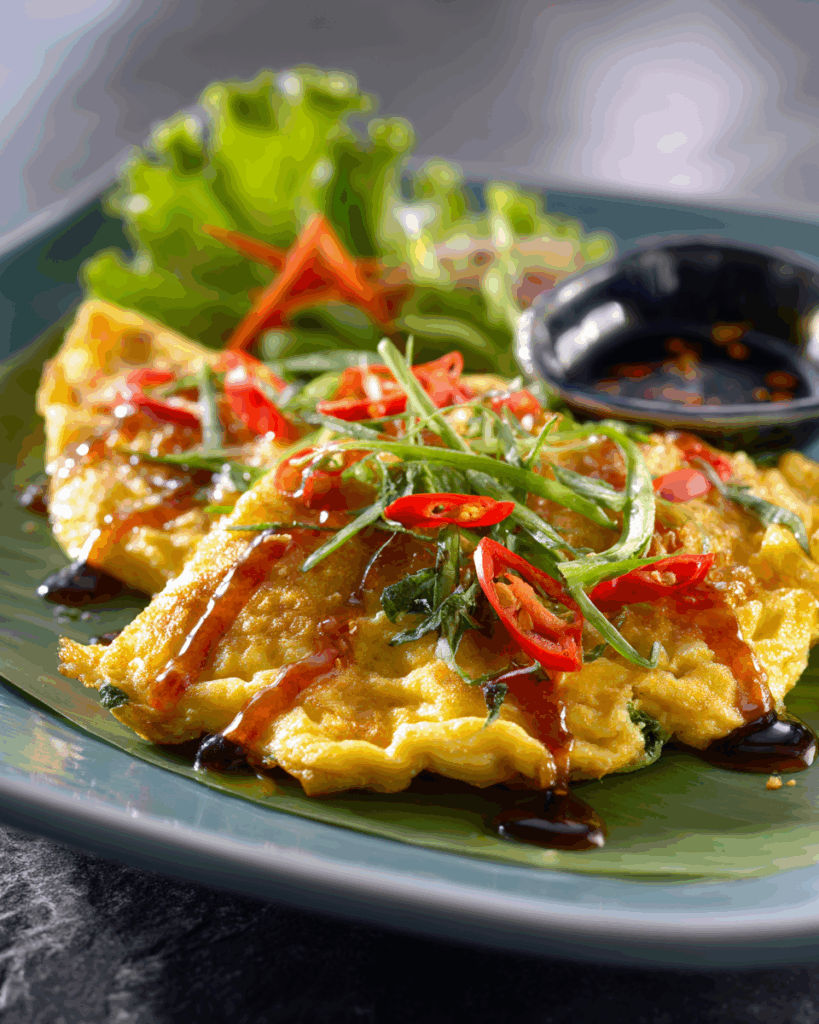
This dish isn’t just a meal—it’s a reflection of Thai culture, history, and everyday life. In Thai households, this omelette is as common as toast or scrambled eggs in Western kitchens. It’s comfort food, a staple at family meals, and a dish with roots deep in rural traditions.
Origins
Cha-om leaves come from the acacia tree, which grows widely in Thailand. For generations, Thai families have used this plant as a readily available ingredient, often picked fresh from gardens or local markets. Because cha-om has a strong smell, cooking it with eggs was a natural way to tame the aroma while still enjoying its health benefits. Over time, this omelette became a staple in everyday Thai cooking.
Role in Thai Cuisine
This omelette is not often found on restaurant menus outside Thailand, but inside the country, it’s beloved. Street vendors sell it as a quick, affordable meal, often served with rice and spicy dips. In rural villages, it’s cooked at home almost daily, especially in central and northeastern Thailand.
Fun Facts
- In some Thai households, the omelette is served with nam prik kapi, a shrimp paste chili dip, to add a spicy punch.
- The cha-om plant is prickly, which is why families often plant it along fences—not just for cooking but also as a natural boundary.
- This omelette is often used as a teaching dish for kids learning to cook because it’s simple yet delicious.
The history of this dish reminds us that great food doesn’t have to be fancy—it just needs to be honest, nourishing, and connected to culture.
Serving Suggestions
When it comes to serving, the options are endless. This dish is versatile, making it perfect for breakfast, lunch, or dinner. Here are some classic and creative ways to enjoy it:
- With Jasmine Rice: The most traditional pairing. A plate of fluffy jasmine rice topped with slices of omelette is pure comfort food.
- With Nam Prik Kapi: This chili shrimp paste dip transforms the omelette into a spicy, tangy meal.
- As a Side Dish: Serve alongside Thai curries like green curry or red curry for a balanced spread.
- With Fresh Vegetables: Pair with cucumber slices, tomatoes, or pickled vegetables to cut through the richness.
- In a Bento Box: The omelette travels well and makes a great addition to lunch boxes.
- With Soup: Combine with Tom Yum or clear broth soups for a complete Thai meal.
- With Thai Iced Tea: For a truly authentic experience, sip Thai iced tea while enjoying your omelette.
The beauty of this dish is that it fits seamlessly into any meal plan, whether as a centerpiece or a complementary side.
When searching for the Thai Cha-Om Omelette Recipe, people also look for related queries like:
- Traditional Thai Cha-Om Omelette Recipe
- Easy Thai Cha-Om Omelette Recipe
- Best Thai Cha-Om Omelette Recipe
- Authentic Thai Cha-Om Omelette Recipe
- Cha-om vegetable
- Thai omelette
- Thai omelette recipe
- Cha-om leaves benefits
By exploring these related searches, it’s clear that the Thai Cha-Om Omelette Recipe isn’t just popular for its taste it’s valued for its tradition, simplicity, and health benefits.
Conclusion
This dish proves that the simplest recipes often hold the deepest meaning. With only a handful of ingredients, this omelette manages to be flavorful, nourishing, and culturally significant. Whether you prepare it for breakfast with rice, enjoy it as a side dish with curry, or make it the centerpiece of a home-cooked Thai dinner, it never disappoints.
By now, you’ve learned not only how to cook it step by step, but also its variations, health benefits, cultural roots, and serving ideas. So why not give it a try tonight? Once you take that first bite of golden egg wrapped around tender cha-om leaves, you’ll understand why this dish has stood the test of time.
Share this recipe with family, bookmark it for your next meal, and keep exploring more Thai classics on Just Thai Recipes.
FAQ
Where can I buy cha-om leaves?
Cha-om leaves are available at Thai and Asian grocery stores. Some online Asian markets also ship them fresh or frozen for cooking.
How do I keep it fluffy?
Whisk the eggs thoroughly, cook on medium-low heat, and avoid overcooking. This ensures a fluffy result every time.
Can I make it vegetarian?
Yes! Simply replace the fish sauce with soy sauce or tamari, and it becomes vegetarian-friendly.
What makes this omelette authentic?
The use of fresh cha-om leaves, fish sauce, oyster sauce, and lime juice gives it its authentic Thai flavor.
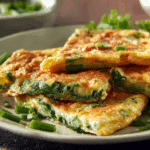
Thai Cha-Om Omelette Recipe
- Prep Time: 10 minutes
- Cook Time: 10 minutes
- Total Time: 20 minutes
- Yield: 2 servings 1x
- Category: Main Course
- Method: Pan-Fried
- Cuisine: Thai
- Diet: Halal
Description
A traditional Thai omelette made with cha-om (acacia) leaves, eggs, garlic, and classic seasonings. Light, fluffy, and full of authentic Thai flavors, perfect with jasmine rice or as a side dish to curries.
Ingredients
- 2 tbsp oil
- 1 clove garlic, minced
- 3 large eggs
- 2 1/2 cups loosely packed acacia (cha-om) leaves, roughly chopped
- 1 tsp fresh lime juice
- 1/2 tbsp oyster sauce
- 1 tbsp fish sauce
Instructions
- Mince your garlic and roughly chop the acacia leaves into 4–5 pieces.
- Crack the eggs into a large bowl, and add the chopped acacia, fish sauce, oyster sauce, and fresh lime juice. Whisk thoroughly until combined.
- Heat oil in a non-stick pan over medium-low heat. Add minced garlic and sauté until golden and aromatic (about 20 seconds).
- Pour your egg mixture into the pan, spreading the acacia leaves evenly. Let it cook for several minutes until one side is cooked through.
- Carefully flip the omelette and cook the other side until golden and fully done.
- Serve hot off the pan with rice or as a side dish.
Notes
- Substitute soy sauce for fish sauce to make it vegetarian-friendly.
- Spinach or tender kale can be used if cha-om leaves are unavailable.
- Cook on medium-low heat to avoid burning the garlic and eggs.
- Best served immediately for the freshest flavor and texture.
Nutrition
- Serving Size: 1 omelette (half recipe)
- Calories: 210
- Sugar: 1 g
- Sodium: 720 mg
- Fat: 15 g
- Saturated Fat: 3.5 g
- Unsaturated Fat: 10 g
- Trans Fat: 0 g
- Carbohydrates: 3 g
- Fiber: 1 g
- Protein: 12 g
- Cholesterol: 185 mg
Keywords: Thai Cha Om Omelette Recipe, Thai omelette, cha-om leaves, authentic Thai omelette, easy Thai omelette, cha-om vegetable


